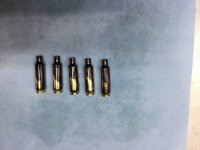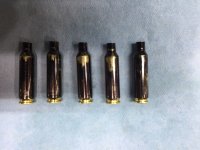Portions of the following was misposted earlier in the All Things Rimfire Forum
After three years of chasing the perfect SD and ES reloads I decided to reset my process. I have been reloading Hornady 6.5 cm brass using ELD M 140gn and Competition HPBT 140gn Hornady bullets. My RPR nodes on 2750 fps +/- so nothing exotic with my charges. Was using H4350 but have had to go to IMR 4350 with the shortages. Primers have been uniformly Federal Premium Match which now has to change but did score 1000 CCI BR4. My process up to now has been SS tumble clean, primer pocket depth and flash hole uniforming, neck resizing with a Redding Competition die set, inside/outside neck and primer pocket chamfering and priming with the Frakfort Arsenal hand primer. I switched to a Auto Trickler from a Charge Master Lite. All in all I get fair results but never ES and SD statistics in the single digits over 10 rounds measured with a LabRadar. Chasing the lands over 2500 +/- rounds has kept me sub .5 moa if I do my part. I have been consistent out to 1400 yards with capable spotting and have hit a mile on every occasion I had the opportunity.
All that said I hope to start shooting 500 yard FClass this next season. Judging from my past results on the 500 yard gong and the Labradar my ES is going to be a hurdle. I’ve tooled up to anneal every reload with an AMP Aztec Annealer and retooled with LE Wilson dies and gauges to full length resize and chamber seat with an AMP Press. Drawing from my Hornady brass which has been reloaded at most three times I started the sizing pricess as specified by the Wilson die/gauge instructions. I also have their minimum chamber gauge and micrometer set up. After running about 200 cases I have 10 that flat refuse to fit the minimum chamber gauge and produce a heavy bolt close in the gun. The Wilson gauges say the length and shoulder dimensions are good and all the measurements I know how to take of the datum and other critical dimensions show under minimum SAAMI chamber. I’ve dialogued with Wilson tech support thinking potentially I have an oversized full length die at mid body because of how the cartridge feels going into the gauge stopping the thickness of the base proud. The base end will slide into the gauge so I know its not a base diameter issue. These 10 rounds also sized heavier on the press than those that fit the min chamber gauge. Wilson has shown no interest in seeing the die nor the brass pieces suggesting I return the die to the seller for a refund.
Is there another explanation any of you reloading gurus can offer that might produce an understanding of what is going on? Is it the die or do I have some super springy brass mid body in theses 10 cartridges? I’ve not loaded any in the chamber seating die so can’t speak to how concentric the fully loaded is.
After three years of chasing the perfect SD and ES reloads I decided to reset my process. I have been reloading Hornady 6.5 cm brass using ELD M 140gn and Competition HPBT 140gn Hornady bullets. My RPR nodes on 2750 fps +/- so nothing exotic with my charges. Was using H4350 but have had to go to IMR 4350 with the shortages. Primers have been uniformly Federal Premium Match which now has to change but did score 1000 CCI BR4. My process up to now has been SS tumble clean, primer pocket depth and flash hole uniforming, neck resizing with a Redding Competition die set, inside/outside neck and primer pocket chamfering and priming with the Frakfort Arsenal hand primer. I switched to a Auto Trickler from a Charge Master Lite. All in all I get fair results but never ES and SD statistics in the single digits over 10 rounds measured with a LabRadar. Chasing the lands over 2500 +/- rounds has kept me sub .5 moa if I do my part. I have been consistent out to 1400 yards with capable spotting and have hit a mile on every occasion I had the opportunity.
All that said I hope to start shooting 500 yard FClass this next season. Judging from my past results on the 500 yard gong and the Labradar my ES is going to be a hurdle. I’ve tooled up to anneal every reload with an AMP Aztec Annealer and retooled with LE Wilson dies and gauges to full length resize and chamber seat with an AMP Press. Drawing from my Hornady brass which has been reloaded at most three times I started the sizing pricess as specified by the Wilson die/gauge instructions. I also have their minimum chamber gauge and micrometer set up. After running about 200 cases I have 10 that flat refuse to fit the minimum chamber gauge and produce a heavy bolt close in the gun. The Wilson gauges say the length and shoulder dimensions are good and all the measurements I know how to take of the datum and other critical dimensions show under minimum SAAMI chamber. I’ve dialogued with Wilson tech support thinking potentially I have an oversized full length die at mid body because of how the cartridge feels going into the gauge stopping the thickness of the base proud. The base end will slide into the gauge so I know its not a base diameter issue. These 10 rounds also sized heavier on the press than those that fit the min chamber gauge. Wilson has shown no interest in seeing the die nor the brass pieces suggesting I return the die to the seller for a refund.
Is there another explanation any of you reloading gurus can offer that might produce an understanding of what is going on? Is it the die or do I have some super springy brass mid body in theses 10 cartridges? I’ve not loaded any in the chamber seating die so can’t speak to how concentric the fully loaded is.



